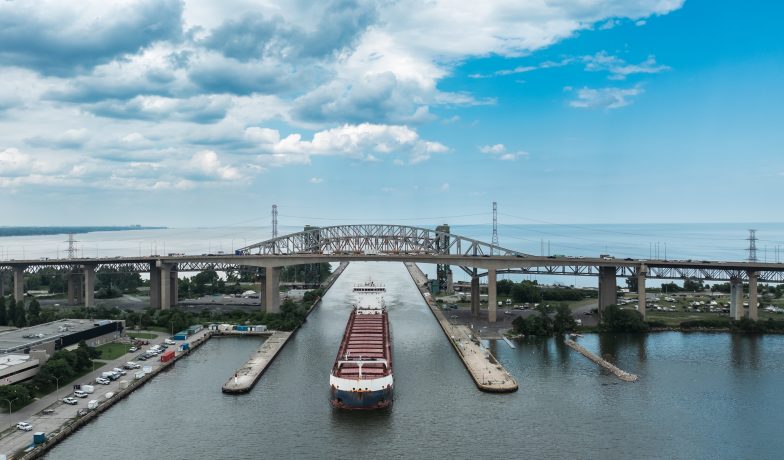67th Navigation Season Well Underway on the Great Lakes-St. Lawrence Seaway

The 2025 season kicked off on March 25 in St. Catharines, Ontario, Canada. Representatives from the SLSMC and the Great Lakes St. Lawrence Seaway Development Corporation (GLS) welcomed the transit of the first commercial vessel of the navigation season, the articulated tug and barge Everlast and Norman McLeod, operated by McAsphalt Marine Transportation Limited.
GLS Deputy Administrator Anthony Fisher spoke about resiliency and the importance of the Great Lakes-St. Lawrence Seaway System as a vital maritime supply chain. “An exceptional reliability record, coupled with significant investments in infrastructure and technology, are enhancing efficiencies and keeping the Seaway System safe and competitive,” he said.
The Great Lakes-St. Lawrence Seaway saw approximately 37 million metric tons of cargo move through the system during the 2024 navigation season. The season, which ran from March 22, 2024, to January 10, 2025, lasted 295 days—making it the longest planned navigation period in the waterway’s history. The system saw strong cargo movement across key sectors, with grain shipments rising 12% year-over-year, potash increasing 14%, liquid bulk up 10% and general cargo also rising 14%.
In December, SLSMC announced it would invest more than $350 million in infrastructure upgrades over the next three years to strengthen supply chain links and improve reliability. “We are committed to supporting growth in North American industries. The Great Lakes-St. Lawrence Seaway System can easily accommodate additional traffic within our existing capacity,” said Jim Athanasiou, president and CEO of SLSMC.
Port to Port
The start of the 2025 season through the end of April saw a 3.7% increase in tonnage compared to the same time last year. Strong movements of grain, dry and liquid bulk cargoes made up for the slower start in iron ore and coal movements. According to the Lake Carriers’ Association, May limestone shipments were down 6.8% compared to one year ago, while shipments of iron ore were down 7.7% compared to 2024.
Athanasiou said the steady performance is encouraging given the current economic climate. “With tariffs and other pressures still unfolding, it’s too early to know the full extent of what lies ahead,” he added.
Both Canadian and U.S. ports are prepared for the rest of the season. The Cleveland—Cuyahoga County Port Authority anticipates slight growth this season at both the Cleveland Bulk Terminal and General Cargo Terminal, with the latter experiencing an 8% increase in general cargo tonnage in 2024 compared to 2023. While steel made up 85% of the 363,247 metric tons of cargo handled at the General Cargo Terminal last season, the port also handled construction cranes and equipment for the Intel plant in New Albany, Ohio. Additional cargo for the Intel project is expected again this season, as well as an increase in the number of passenger cruise ship calls, which will rise to 55 from the 22 visits in 2024.
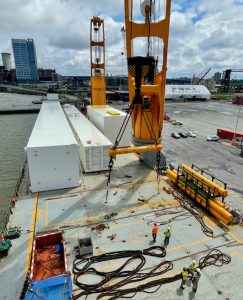
The Cleveland Bulk Terminal expects demand for iron ore to maintain at its current level or increase approximately 10% in 2025, barring any blast furnace complications at Cleveland-Cliffs. The terminal had a solid year in 2024, handling 3.358 million metric tons of cargo, with 86 inbound vessels and 205 outbound vessels.
The Port of Cleveland will also see the continuation of several infrastructure improvement projects. Phase one of the $1.5 million ship loader and ore tunnel modernization project gets underway in 2025. The port will also continue with planning, procurement and construction of the Terminal Electrification & Warehouse A Modernization project. Construction of the $12.5 million project is projected to be completed in 2026. The port also plans to invest approximately $600,000 into the rehabilitation of its fabric warehouse, which also serves as the facility’s primary Foreign-Trade Zone (FTZ) space.
On April 21, the Port of Duluth-Superior welcomed the Federal Nagara, the first saltie to transit the full St. Lawrence Seaway for the 2025 international navigation season. The port handled 26.85 million metric tons of cargo during the 2024 season, which was a 6.8% decline compared to 2023. A decrease in iron ore shipments drove the decline, with taconite totals falling from a 28-season high in 2023 to approximately 17.6 million metric tons in 2024. Despite the overall tonnage decline, the Port of Duluth-Superior celebrated several successes last season, including a 70% year over year increase in breakbulk cargoes moving through the Clure Public Marine Terminal. Export tonnage increased by 31 percent, with spring wheat shipments more than tripling from 2023.

The Port of Green Bay kicked off the 2025 shipping season on March 12 with the arrival of the Innovation with tug Samuel De Champlain. The port handled 1.538 million metric tons of cargo last season, a 6% decrease compared to the 2023/2024 season. Shipments of salt, limestone and petroleum products were down in 2024, while volumes of cement and coal increased. Cement was up 21% while liquid asphalt was up 10%, which, according to Port of Green Bay Director Dean Haen, is indicative of a strong construction industry in northeastern Wisconsin.
HOPA Ports saw a combined total cargo of 11.46 million metric tons through the ports of Hamilton and Oshawa and the Thorold Multimodal Hub during the 2024 navigation season. Steel-making commodities made up 47.5% of total HOPA cargo, while agri-food represented 31% of total cargo volume. The Port of Hamilton saw a nearly 30% increase in raw sugar tonnage over the 2023 season, exceeding 180,000 metric tons. The port expects that number to climb with the opening of the Sucro Can Sugar Refinery, which will have an annual refining capacity of 1 million metric tons. In addition to the sugar refinery, HOPA Ports has a series of infrastructure improvements all aimed at increasing productivity.
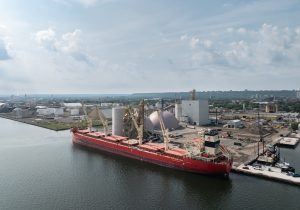
- Parrish & Heimbecker, Limited is expanding its flour mill at the Port of Hamilton. The project includes a third flour mill and two new storage silos. The project is expected to be complete in late 2025.
- An expanded grain terminal at the Port of Oshawa is now open, offering 20,000 metric tons of storage capacity. It features a vessel loading rate of up to 12,000 metric tons per day.
- The Toronto Tank Lines (TTL) Rail Transload Terminal for liquid products opened at the Port of Hamilton in 2024. In its first year of operation, the facility handled more than 2,000 railcars, supporting supply chains in Ontario’s food manufacturing and processing sector.
- New stormwater management and surfacing at Thorold Hub North in Niagara will increase cargo handling capacity, reduce dust and improve water quality protection.
- HOPA partner Hamilton Container Terminals is waiting on the approval from Canada Border Services Agency (CBSA) for a new completed inland rail terminal that will enable more efficient distribution of containerized goods.
Ian Hamilton, president and CEO of HOPA Ports, said these investments in infrastructure will make supply chains within Canada as efficient and productive as possible. “We may be under a cloud of uncertainty, but we believe we are doing the right things to maximize resiliency,” Hamilton said. “We have invested in trade-enabling infrastructure that enhances our economic relationships with a range of global partners. Most grain exports, for example, are destined for markets in Europe.”
The Illinois International Port District predicts a challenging, but comparatively average season for 2025 based on tenants’ corporate projected annual tonnage. The port handled 2.32 million metric tons of cargo in 2024, including liquid chemicals and ethanol, steel, lumber and plywood, cement and bulk food cargo.
Port tenants predict the tariffs, a down chemical market and lock outages might have a negative impact on the rest of the season.
Metro Ports recently signed a five-year extension of their bulk terminal operating agreement at Ports of Indiana-Burns Harbor. Metro Ports is one of the longest-operating stevedores in the United States. The company has managed bulk cargo handling at Burns Harbor since 2017 and oversees the movement of materials such as coking coal, limestone, iron ore pellets, grains and minerals via ocean vessels, Great Lakes ships, river barges and railcars.
This extension comes shortly after Ports of Indiana-Burns Harbor welcomed its first ocean vessel of the 2025 international shipping season. The M/V Pile, a bulk carrier owned and operated by Polish marine line Polsteam, arrived at Burns Harbor on April 11, delivering 8,300 metric tons of specialized steel products that will be used by local manufacturers.
During the 2024 season, Burns Harbor handled 2.54 million metric tons of barge, laker and ocean cargo, up 5% from the prior year.
The Port of Johnstown anticipates a strong and healthy 2025 after coming off a record-breaking navigation season. Total cargo processed at the port was 1.46 million metric tons in 2024. The total throughput of grain was 982, 024 metric tons, an increase of 45,788 metric tons from 2023. The port saw the highest grain movement by vessel on record last season, with 16 shipments of soybean and 10 shipments of corn. Eleven of those grain shipments were exported internationally to Ireland, Great Britain and Italy.
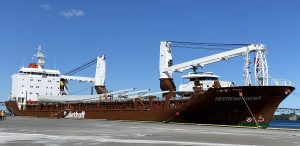
The Port of Johnstown recently formed a partnership with V6 Agronomy, a Canadian soil nutrient company specializing in high performance enhanced efficiency compound fertilizers. The long-term partnership will allow the port to serve as V6 Agronomy’s Eastern Canadian import hub for its fertilizer products. The new terminal facility is expected to be operational in late 2025.
The port invested nearly $7.8 million in infrastructure improvements last year, including bin wall repair work, spout repair in the shipping area and pavement resurfacing projects. A new grain dryer, supported by Agri-Food Canada ACT funding, was also installed. The port expects approximately $4.3 in facility improvements this year.
Port Milwaukee is cautiously optimistic for the remaining 2025 international shipping season, which started on March 30 with the arrival of the Patagonman. Jackie Q. Carter, port director, cites the uncertain changes around United States tariffs and the impact of supply chains. “Until there is a clear path forward on tariffs, we are unable to project activity on imported products with any real confidence,” Carter said in a statement. “We do, however, foresee continued growth in agriculture exports and remain hopeful that overall throughput will remain at current levels or with a slight increase.”
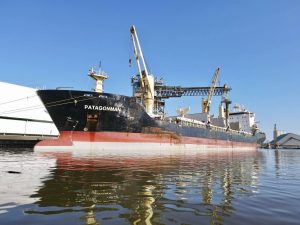
The long 2024 international shipping season ended December 28, making it the latest vessel departure on record. Port Milwaukee’s 2024 season saw a slight decline in total overall tonnage, with 2.23 million metric tons handled, but strong growth in international throughput. Steel imports and agriculture exports were the main drivers of the growth in international trade.
Infrastructure improvements have been a top priority for Port Milwaukee over the last several years. Last year, the port invested $2 million to renovate Terminal 3. Expansion plans are now underway for the DeLong Agriculture Maritime Export Facility, which will lead to additional storage capacity and conveyance equipment. The investment in the facility will allow for the handling of multiple commodities simultaneously. The project is expected to cost approximately $16 million with portions being funded through state and federal grants.
The Port of Monroe anticipates 2025 to be a big year for bulk cargo exports. The port handled approximately 1.9 million metric tons of cargo last year, including the import of a reconditioned 390-generator stator. The port also rolled off two absorber towers for a battery plant in Windsor, Ontario, and rolled off two trailers from Windsor, bound for Mexico. “Our 2024 activity shows how the Port of Monroe can play a key role in regional construction projects,” said Sam Hankinson, port development coordinator at the Port of Monroe. “New infrastructure will enhance our ability to respond to any logistics challenge.”
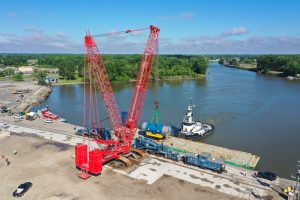
The Port of Monroe has more than $30 million in federal, state and local funding to support infrastructure improvements. A grant from the Michigan Department of Transportation has funded the installation of a RORO platform at the port’s turning basin deck. This project is in addition to the container-capable handling facility, and Port Infrastructure Development Program (PIDP) grant projects that are scheduled to take place at the port this year.
Earlier this year, the Government of Quebec announced $130 million CAD in funding to the Montreal Port Authority for its project to build a container terminal at Contrecœur. The Contrecœur terminal expansion at Port of Montreal will be able to handle 1.15 million containers. The project will include two berths, a container yard, an intermodal rail yard, secondary facilities and a truck control zone. The project is expected to be completed in 2029 and cost a total of $1.575 billion CAD.
Despite an interruption of services due to a strike and lockout involving the Canadian Union of Public Employees (CUPE) 375 and the Maritime Employers Association (MEA), the Port of Montreal reported steady overall tonnage in 2024 compared to the previous year. The port handled 35.26 million metric tons of cargo last year, a 0.25% drop compared to 2023.
The Toledo-Lucas County Port Authority anticipates a promising 2025 navigation season thanks to a series of infrastructure improvements, including the completion of a new dock wall and liquid transloading facility at the General Cargo Dock, operated by Midwest Terminals of Toledo International. The Port of Toledo is also expanding the General Cargo Facility by approximately 50 acres with the inclusion of Cedar Island, an undeveloped area adjacent to the terminal. Additionally, the construction of a new 50,000-square-foot Resilient Cargo Storage Warehouse, a support facility for the newly constructed liquid transload facility, will begin later this year. This $4.6 million investment is funded through the Ohio Department of Transportation’s Maritime Assistance Program.
In 2024, approximately 10.27 million metric tons of cargo traveled through the Port of Toledo, with iron ore making up 52% of this total. The port also witnessed a 30.64% increase in aluminum primarily due to activity prompted by the London Metals Exchange.

The Port of Toronto points to the success of the 2024 navigation season as another reason why it plays a critical role in the regional economy. The port handled 2.3 million metric tons of cargo last season, including 591,265 metric tons of sugar from Central and South America to support Toronto’s food and beverage industry. “We are making key investments, including the rehabilitation of the Ship Channel Lift Bridge, to ensure the continued movement of goods and people,” said RJ Steenstra, president and CEO of PortsToronto. “This modernization has the potential to increase cargo tonnage, support heavy component shipments and boost cruise ship passenger volumes, while also enhancing the efficiency of our terminal and warehouse facilities.
The largest construction project in the history of the Port of Trois-Rivières continues during the 2025 navigation season. The project, which began in May 2024, involves several phases, including the reconstruction of Pier 17, the filling of the basin, the construction of a new Pier 16 and the development of the adjacent terminals. This project will support the aluminum and agri-food industries, which are key sectors of the Quebec and Canadian economies.
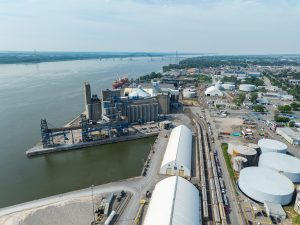
Officials anticipate 2025 tonnage rates to remain comparable to 2024, when 3.5 million metric tons of cargo transited through the port, with dry bulk making up approximately 82%. Last season saw a 16.7% decrease in cargo compared to 2023, which port officials anticipated due to the extensive construction projects taking place at the port.
Port Windsor anticipates a relatively strong 2025 shipping season thanks to an expansion in grain capacity. Salt mining and shipments also resume this year after an inventory adjustment. The 2024 shipping season was considered a year of transition due to construction, upgrades and inventory adjustments. The port handled 3.15 million metric tons of cargo, down from 3.79 million metric tons in 2023.
According to port officials, the U.S. tariffs on Canadian imports have affected some of the Windsor terminals this season, resulting in canceled orders that could potentially negatively impact other port operations.
The port is currently investing $150 million CAD to expand existing capacity and lower its carbon footprint. A new cargo dock is currently under construction that will be capable of handling short sea shipping containers and RORO for the import and export of automobiles. The port is also increasing its capacity to receive and export more local grains. Steps are also being taken to build upon Port Windsor’s position as the first and largest biodiesel marine fueling depot on the Great Lakes.
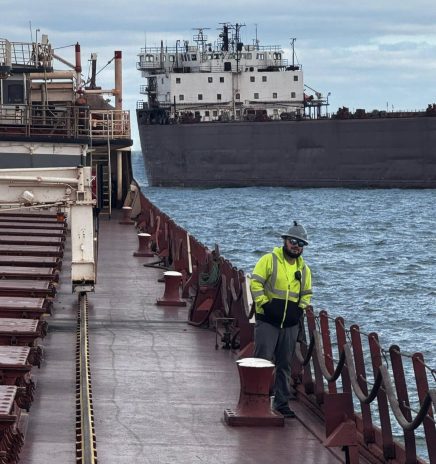
Great Lakes Limestone and Iron Ore Trade Down in September
Shipments of limestone on the Great Lakes totaled 3.3 million tons in September, a decrease of 11.5% compared to 2024, according to the Lake Carriers’ Association. Limestone cargos were also... Read More
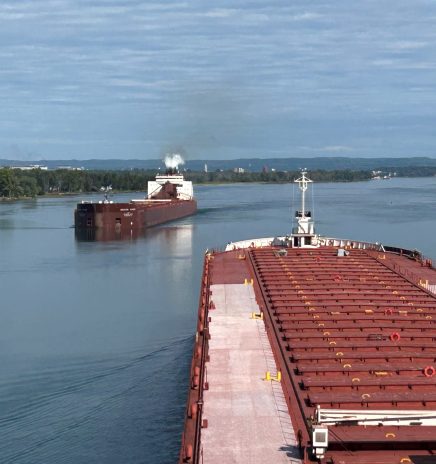
Great Lakes Limestone and Iron Ore Trade Down in August
Shipments of limestone on the Great Lakes totaled 3.6 million tons in August, a decrease of 3% from 2024. Limestone cargos were also below the month’s 5-year average by 4.4%.... Read More

